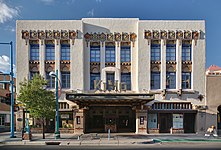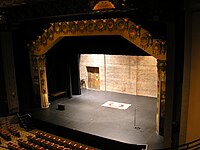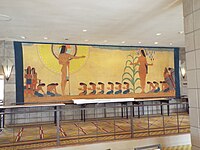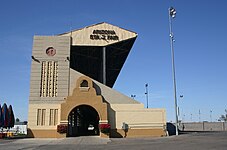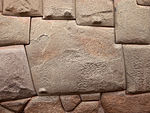Pueblo Deco architecture
Pueblo Decois anarchitectural stylein theSouthwestern United Statespopular in the early 20th century. Pueblo Deco fused elements ofArt Decowith the region'sPuebloandTerritorialarchitectures, themselves inspired byPuebloandTerritorial Styles.[1]Early Pueblo Deco design was influenced by architectMary Colter's work, which incorporated Native American elements. The term was popularized by author Carla Breeze, whose 1984Pueblo Deco: The Art Deco Architecture of the Southwest(written with Marcus Whiffen), and 1990Pueblo Decobooks described the fusion of southwestern motifs with the popular Deco style. Notable examples of buildings incorporating Pueblo Deco elements include theKiMo TheaterinAlbuquerque, New Mexicoand theArizona Biltmore HotelinPhoenix, Arizona.[2]
Pueblo Revival style is associated with Art Deco's borrowing of non-Western stylistic elements, principally from Egyptian, Asian and in this case indigenous sources. The style emphasizes applied ornament, often in metalwork, together with extensive tilework and wall murals. Additional structures incorporating Pueblo Deco design include theEl Navajo Hoteland theMcKinley County Courthouse,both in Gallup, New Mexico.[3]
Gallery
[edit]-
Stageof the KiMo Theater
-
Interior detail of the KiMo Theater
-
Exterior detail of the KiMo Theater
-
"Biltmore Blocks" of the Arizona Biltmore Hotel.
-
Interior of the Aztec Room in the Arizona Biltmore Hotel.
-
Depiction of the "Legend of the Sun" in the Arizona Biltmore Hotel.
-
McKinley County Courthouse inGallup,New Mexico (1938)
-
grandstand at theArizona State FairgroundsinPhoenix, Arizona(1936)
References
[edit]- ^Mahoney, T.R.; Katz, W.J. (2008).Regionalism and the Humanities.University of Nebraska Press. p. 71.ISBN978-0-8032-2046-1.RetrievedFebruary 14,2022.
- ^Daniels, Mary (November 11, 1990)."Pueblo Deco: Americana Architecture".Chicago Tribune.Retrieved3 July2013.
- ^Pry, Mark E. (1996)."National Register of Historic Places Registration Form: Kinjockity Ranch".National Park Service.Retrieved2 July2013.

